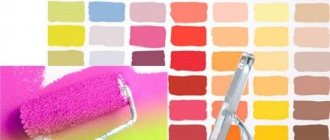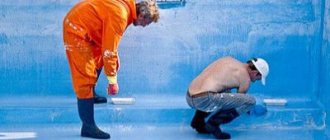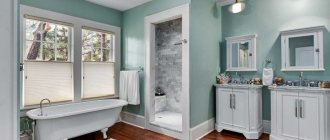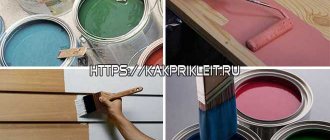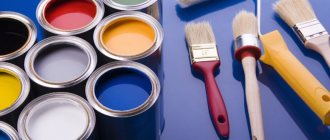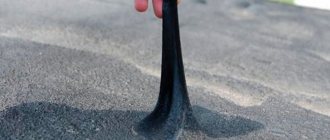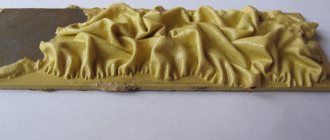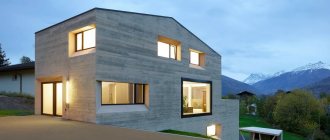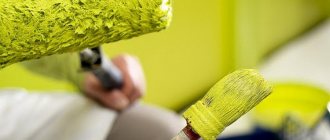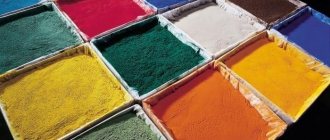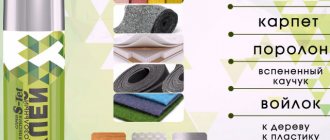When creating an exclusive interior of a room, textured wall painting is an excellent solution. This type of finishing does not require special skills or sophisticated equipment; all work is carried out exclusively with your own hands, which allows you to show your imagination and implement design solutions. For painting, special textural and decorative mixtures or traditional compositions applied in a certain way are used.
Types and manufacturers
Today, manufacturers of paints and varnishes offer a wide range of textured paints.
Textured paints differ from each other, first of all, in the size and type of filler, which allows you to create the desired layer structure and recreate some natural textures.
For example, paint like “bark beetle” (read about bark beetle facade) imitates a wood surface damaged by insects.
No less widespread are the “lamb” and “fur coat” effects, which have a uniformly rough relief of varying heights.
External use somewhat limits the possibilities of relief paints, since atmospheric or weather conditions interfere with the situation.
In this regard, we have to work at a faster pace, so some types of coatings that are successfully carried out on internal surfaces become impossible to perform on the facade.
Most often on the modern construction market you can find relief paints based on water-based acrylic mixtures - they are the ones that most successfully combine performance characteristics, performance qualities and cost.
However, some manufacturers very successfully produce textured dyes based on organic solvents, using traditional, time-tested materials.
Thus, experts identify the following types of texture dyes:
- Vinyl. Are used only for external work. The binding component is plastic or vinyl filler. They are characterized by a high level of adhesion, a good level of protection from negative external influences and low permeability. Difficult to work with: the plasticity of the paint makes it difficult to apply a textured pattern.
- Acrylic. They have a rich range of colors and are water-based. They are especially popular due to their plasticity. Allows you to create reliefs of any complexity. Easily diluted to any consistency and shade. The composition is absolutely environmentally friendly and safe for health, but is poorly protected from exposure to ultraviolet radiation and chemical solvents.
- Silicone. They are durable. They reliably protect facades from the effects of negative factors, including ultraviolet radiation and moisture. High level of vapor permeability. The paints have good viscosity and plasticity, which allows you to give the walls any voluminous texture. Perfectly masks defects of the treated surface.
- Silicate (polymer). The main component is liquid glass, which has a high level of vapor permeability and good adhesive properties. Decorative polymers effectively repel dirt, dust and moisture, have a long service life and reliably protect the facade from external influences. To carry out the work, a significant consumption of material is required.
- Mineral. These dyes are based on cement. Paints of this type are vapor-permeable and moisture-resistant, fit beautifully into a textured pattern and are able to create an attractive relief. However, mineral components do not tolerate sudden temperature changes, so during severe winter frosts the design may crack.
When choosing a finishing material, it is necessary to consider what surface the paint will be applied to. As a rule, manufacturers indicate on the packaging what types of facades a particular composition is suitable for.
"Latek"
Textured paint “Latek” allows you to get a textured rough surface. The coating does not require careful surface preparation, perfectly masks minor imperfections in the walls, and also forms a hard coating that can easily withstand wet cleaning. Ideal for processing plaster, concrete, plasterboard and brick.
Distinctive features are: almost complete absence of odor, environmental friendliness and fire and explosion safety.
Apply using a roller at temperatures from +5°C to +35°C. Complete drying requires from 24 to 72 hours depending on the thickness of the applied layer and surface texture.
Today the cost of such paint is about 60 rubles per kilogram.
Preparation before painting
This stage is very similar to preparing for the application of usually water-based paint. However, due to the greater viscosity of the textured composition, the strength requirements for the base in this case are an order of magnitude higher.
Operating procedure:
- Preparing the premises. Carrying out repairs of this type is accompanied by the formation of a large amount of dust and dirt. Therefore, it is recommended to completely empty the premises of all furniture and decorative items, remove chandeliers and lamps. Those items that cannot be removed due to their size should be moved to the center of the room and covered with film. Also, the entire floor area is covered with polyethylene (if the final floor finishing has already been laid).
- Stripping off the old finish. The walls and ceiling (if it will also be finished) are cleaned of all old finishing. Ideally, bare panels or plaster should be left. All fragments of the rough base that do not hold well and vibrate when touched must be beaten off with a hammer or pick. The cleaned surface is thoroughly impregnated with primer.
- Plaster, putty. After the primer has dried, a leveling layer of plaster or starting putty is applied. As a rule, the walls are leveled with plaster, and the ceiling with putty. At this stage, it is important to achieve visual smoothing of all irregularities, for which you can use the rule and beacons. If the base is mostly flat, apply finishing putty immediately (in 2-3 layers).
- Grinding. After waiting for the last layer of putty to dry completely (this usually takes at least a day), sanding is carried out using painting sandpaper (No. 120-140). If in the future you plan to use decorative paint that forms a texture, you can be lenient with minor scratches during sanding: they will not be noticeable on the finished surface.
- Finishing primer. A very important stage, since it is important to achieve the most uniform thickness of the primer layer over the entire application area. Otherwise, the finish will contain unevenness. It is recommended to use acrylic impregnation as a material, coating the base with it in 1-2 layers. The pause for drying one layer is approximately 6 hours.
Applying textured paint with a roller: instructions and video
To apply textured paint with a roller, you will need several rollers of different widths.
Using a large roller, apply the first layer using vertical movements. Then, using a small roller, inaccuracies and areas in hard-to-reach places are corrected.
If you wrap a roller with rope and make vertical (from bottom to top) movements along the surface of the wall, you can create an imitation of stems.
To obtain more complex designs, it is recommended to use special structural rollers with a ready-made ornament applied to them.
A video on this topic can be found below:
Application by brush
The process of applying textured paint using a brush is presented in the following video:
Structural facade paint for exterior use
What is structural wall paint
Structural paint for walls is the second name for textured paints intended for outdoor work.
Application methods
The structure of the treated surface largely depends on the composition of the paint, namely, on the type and size of the filler it contains.
Therefore, you need to choose it extremely carefully, focusing on the samples presented.
However, it is within the power of the master to independently change the relief, to make it more artistic or deeper. The main thing is to choose the method of applying the material to the walls.
There are several main methods of applying structural paints to the facade:
- With a brush. If you want to get an unusual texture, you need to apply the paint with a brush not in the usual way, but in large strokes. Moreover, they can be either parallel, cross or chaotic - it all depends on the imagination and dexterity of the master. You can also first coat the wall with an even layer of paint, and then use the same or another, harder brush to “stir” the resulting coating.
- With a roller. The type of roller coat dictates what kind of relief the future coating will have. You can use both foam rubber and fur rollers - in each individual case the pattern will be individual. As an option, you can use a structured roller and run it over the surface after applying the main coat of paint, but in this case the coating should not be too thin.
- With a sponge. The process is longer, but no less effective. To obtain an interesting pattern, you need to make “blotting” movements along the wall with a sponge soaked in the composition. The higher the porosity of the sponge, the more prominent the texture. In construction stores you can find special sponges intended for this purpose - natural sea sponges.
- With a spatula. The thickness and viscosity of structural paints allow them to be applied using a spatula. In this case, there is no need to smooth the resulting coating - the more chaotic the strokes, the more interesting the relief will be. The texture of the coating is also affected by the size and rigidity of the spatula.
In the absence of sufficient practice, any of the above methods may seem quite difficult to use on your own.
In this case, experts recommend proceeding as follows: one person applies paint to the wall in any convenient way, trying to create a layer of the same thickness, and the second person then structures it with the tools listed above.
At the same time, you can draw on a freshly painted surface with any other devices: a comb, a notched trowel, a crumpled bag, or just your fingers.
The main thing is to try not to push the coating to the base so that it does not show through deep scratches. However, if you pre-coat the walls with regular paint, you can get a rather interesting and unusual effect.
Options for obtaining the required invoice
To obtain an unusual relief, there are various methods that use a variety of tools and devices.
In general, any suitable materials and tools can be used for the job. Even with your hands you can create an interesting relief.
If desired, with simple tools you can create genuine masterpieces on the walls
Advice! It is recommended to test all created effects on a small area of plywood or cardboard, this will give you an idea of the final result.
Where to buy textured and structural paint for exterior use?
In Moscow
In Moscow you can buy textured facade paint in stores such as:
- “Italian Paints Salon”: official website: https://www.paint-shop.ru;
- address: Moscow, Gilyarovskogo street, house 65;
- telephone.
- official website: https://www.mirkrasok.ru
- official website: https://domsmesey.ru;
- official website: https://www.kraski.ru;
In St. Petersburg
In St. Petersburg, structural wall paint is sold in the following organizations:
- "Amesa": official website: https://amesa-spb.ru;
- address: St. Petersburg, Moskovsky prospect, building 111, section 17;
- telephone.
- official website: https://www.alt-x.ru;
- official website: https://www.decomix.ru;
- official website: https://liderdecor.ru;
Thus, correctly selected textured and structural paint for walls is not only a durable decorative composition and decoration of the facade, but also protects the surface from many negative factors. That is why the choice of facade dye should be taken with full responsibility and more attention should be paid to the quality than the price of the material.
Did this article help you? We would be grateful for your rating:
